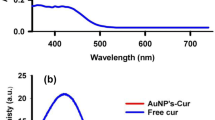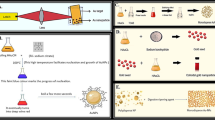Abstract
Gold nanoparticles synthesized using plant extracts with medicinal properties have gained traction in recent years, especially for their use in various biomedical applications. Colloidal stability of these nanoparticles in different environments is critical to retain the expected therapeutic/diagnostic efficacy and toxicological outcome. Any change in the colloidal stability leads to dramatic changes in the physico-chemical properties of the nanoparticles such as size and surface charge, which in turn may alter the biological activity of the particles. Such changes are imminent in physiologically-relevant environment wherein interactions with different biomolecules, such as serum proteins, may modify the overall properties of the nanoparticles. In this regard, we synthesized 15 nm sized gold nanoparticles using curcumin, a plant extract from turmeric root, to evaluate cytotoxicity, uptake, and localization in human prostate cancer cells using cell-culture medium supplemented with or without fetal bovine serum (FBS). The results indicate a dramatic difference in the cytotoxicity and uptake between cells treated with curcumin-functionalized gold nanoparticles (cur-AuNPs) in cell-culture medium with and without serum. The addition of FBS to the medium not only increased the stability of the nanoparticles but also enhanced the biocompatibility (i.e. minimal cytotoxicity for a wide range of cur-AuNP concentrations). We conclude that the presence of serum proteins significantly impact the therapeutic potential of cur-AuNPs.









Similar content being viewed by others
References
Anand P, Kunnumakkara AB, Newman RA, Aggarwal BB (2007) Bioavailability of curcumin: problems and promises. Mol Pharm 4:807–818
Boisselier E, Astruc D (2009) Gold nanoparticles in nanomedicine: preparations, imaging, diagnostics, therapies and toxicity. Chem Soc Rev 38:1759–1782. https://doi.org/10.1039/b806051g
Coates JP (1996) The interpretation of infrared spectra: published reference sources. Appl Spectrosc Rev 31:179–192
Das RK, Sharma P, Nahar P, Bora U (2011) Synthesis of gold nanoparticles using aqueous extract of Calotropis procera latex. Mater Lett 65:610–613. https://doi.org/10.1016/j.matlet.2010.11.040
Dreaden EC, Alkilany AM, Huang X, Murphy CJ, El-Sayed MA (2012) The golden age: gold nanoparticles for biomedicine. Chem Soc Rev 41:2740–2779
Fröhlich E (2012) The role of surface charge in cellular uptake and cytotoxicity of medical nanoparticles. Int J Nanomed 7:5577–5591
Gangwar RK et al (2012) Conjugation of curcumin with PVP capped gold nanoparticles for improving bioavailability. Mater Sci Eng C 32:2659–2663
Hatcher H, Planalp R, Cho J, Torti FM, Torti SV (2008) Curcumin: from ancient medicine to current clinical trials. Cell Mol Life Sci 65:1631–1652. https://doi.org/10.1007/s00018-008-7452-4
Hotze EM, Phenrat T, Lowry GV (2010) Nanoparticle aggregation: challenges to understanding transport and reactivity in the environment. J Environ Qual 39:1909–1924
Jain S, Hirst DG, O’Sullivan JM (2012) Gold nanoparticles as novel agents for cancer therapy. Br J Radiol 85:101–113. https://doi.org/10.1259/bjr/59448833
Kittler S et al (2010) The influence of proteins on the dispersability and cell-biological activity of silver nanoparticles. J Mater Chem 20:512–518
Levchenko LA et al (2011) Synthesis and study of gold nanoparticles stabilized by bioflavonoids. Russ Chem Bull 60:426. https://doi.org/10.1007/s11172-011-0067-1
Mahl D, Greulich C, Meyer-Zaika W, Köller M, Epple M (2010) Gold nanoparticles: dispersibility in biological media and cell-biological effect. J Mater Chem 20:6176–6181
Manju S, Sreenivasan K (2012) Gold nanoparticles generated and stabilized by water soluble curcumin–polymer conjugate: blood compatibility evaluation and targeted drug delivery onto cancer cells. J Colloid Interface Sci 368:144–151
Moore TL et al (2015) Nanoparticle colloidal stability in cell culture media and impact on cellular interactions. Chem Soc Rev 44:6287–6305
Nune SK et al (2009) Green nanotechnology from tea: phytochemicals in tea as building blocks for production of biocompatible gold nanoparticles. J Mater Chem 19:2912–2920
Parida UK, Bindhani BK, Nayak P (2011) Green synthesis and characterization of gold nanoparticles using onion (Allium cepa) extract. World J Nano Sci Eng 1:93
Priyadarsini KI (2014) The chemistry of curcumin: from extraction to therapeutic agent. Molecules 19:20091–20112
Sanna V et al (2014) Single-step green synthesis and characterization of gold-conjugated polyphenol nanoparticles with antioxidant and biological activities. Int J Nanomed 9:4935
Shukla R et al (2008) Soybeans as a phytochemical reservoir for the production and stabilization of biocompatible gold nanoparticles. Small 4:1425–1436
Sindhu K, Rajaram A, Sreeram K, Rajaram R (2014) Curcumin conjugated gold nanoparticle synthesis and its biocompatibility. RSC Adv 4:1808–1818
Singh C, Baboota RK, Naik PK, Singh H (2012) Biocompatible synthesis of silver and gold nanoparticles using leaf extract of Dalbergia sissoo. Adv Mater Lett 3:279–285
Singh DK, Jagannathan R, Khandelwal P, Abraham PM, Poddar P (2013) In situ synthesis and surface functionalization of gold nanoparticles with curcumin and their antioxidant properties: an experimental and density functional theory investigation. Nanoscale 5:1882–1893
Sneha K, Sathishkumar M, Lee SY, Bae MA, Yun Y-S (2011) Biosynthesis of Au nanoparticles using cumin seed powder extract. J Nanosci Nanotechnol 11:1811–1814
Sperling RA, Rivera Gil P, Zhang F, Zanella M, Parak WJ (2008) Biological applications of gold nanoparticles. Chem Soc Rev 37:1896–1908. https://doi.org/10.1039/b712170a
Sreelakshmi C, Goel N, Datta K, Addlagatta A, Ummanni R, Reddy B (2013) Green synthesis of curcumin capped gold nanoparticles and evaluation of their cytotoxicity. Nanosci Nanotechnol Lett 5:1258–1265
Teiten M-H, Eifes S, Dicato M, Diederich M (2010) Curcumin—the paradigm of a multi-target natural compound with applications in cancer prevention and treatment. Toxins 2:128–162
Yallapu MM, Jaggi M, Chauhan SC (2012) Curcumin nanoformulations: a future nanomedicine for cancer. Drug Discov Today 17:71–80
Acknowledgements
This research was financially supported by the Telus Ride for Dad and the Prostate Cancer Fight Foundation. We are thankful to Prof. Jonathan Blay for his help with the phase contrast microscope.
Author information
Authors and Affiliations
Corresponding author
Additional information
Publisher’s Note
Springer Nature remains neutral with regard to jurisdictional claims in published maps and institutional affiliations.
Electronic supplementary material
Below is the link to the electronic supplementary material.
Rights and permissions
About this article
Cite this article
Nambiar, S., Osei, E., Fleck, A. et al. Synthesis of curcumin-functionalized gold nanoparticles and cytotoxicity studies in human prostate cancer cell line. Appl Nanosci 8, 347–357 (2018). https://doi.org/10.1007/s13204-018-0728-6
Received:
Accepted:
Published:
Issue Date:
DOI: https://doi.org/10.1007/s13204-018-0728-6




